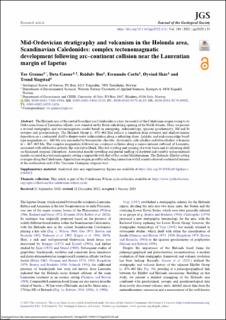Mid-Ordovician stratigraphy and volcanism in the Hølonda area, Scandinavian Caledonides: complex tectonomagmatic development following arc–continent collision near the Laurentian margin of Iapetus
Peer reviewed, Journal article
Published version
Permanent lenke
https://hdl.handle.net/11250/3092984Utgivelsesdato
2023Metadata
Vis full innførselSamlinger
- Import fra CRIStin [3604]
- Institutt for miljø- og naturvitskap [528]
Sammendrag
The Hølonda area of the central Scandinavian Caledonides is a key for models of the Caledonian orogen owing to its Ordovician fauna of Laurentian affinity, now stranded on the Baltic side during opening of the North Atlantic. Here, we present a revised stratigraphic and tectonomagmatic model based on remapping, sedimentology, igneous geochemistry, Nd and Sr isotopes and geochronology. The Hølonda Group (c. 470–461 Ma) reflects a transition from subaerial and shallow-marine deposition on a continental shelf to deeper-water sedimentation along a subsiding slope. Adakitic and mid-ocean ridge basalt type magmatism at c. 468 Ma was succeeded by benmoreitic–rhyolitic, shoshonitic, calc-alkaline and ultra-alkaline volcanism at c. 467–465 Ma. The complex magmatism followed arc–continent collision along a microcontinent outboard of Laurentia, associated with subduction polarity flip and slab rollback. This led to rifting and opening of a wide basin and its adjoining shelf on thickened orogenic lithosphere. Associated mantle upwelling and partial melting of depleted and variably metasomatized mantle occurred in a tectonomagmatic setting comparable with that of the central Mediterranean. The Hølonda–Ilfjellet setting is unique along the Caledonian–Appalachian orogen, possibly reflecting interaction with Laurentia-derived continental terranes at the northeastern end of the Taconian–Grampian orogenic tract.

